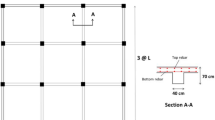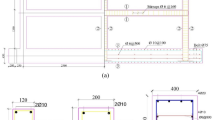Abstract
The construction industry faces the imperative of reconciling structural integrity with environmental sustainability, urging a nuanced exploration of the material choices and design parameters. This study investigated the seismic design and embodied carbon implications of varying concrete grades and column spacing in concrete moment frames. A systematic approach was employed, conducting seismic design analyses and embodied carbon assessments for concrete moment frames with concrete grades of C25/30, C32/40, and C40/50 and column spacings of 4, 6, and 8 m. The results highlight the intricate influence of concrete grades on the resulting beam and column designs, with C32/40 emerging as the optimal choice, showing a substantial reduction in total embodied carbon. Additionally, column spacing is pivotal in shaping the beam design parameters, exhibiting a positive correlation between reduced column spacing and lower embodied carbon. This study contributes useful insights into the ongoing discourse on sustainable construction, offering a balanced perspective on the complex interplay between structural design choices and environmental implications.








Similar content being viewed by others
Data availability
No datasets were generated or analysed during the current study.
References
ACI (2019) Building code requirements for structural concrete, pp. 318–19
ASCE (2016) ASCE/SEI 7–16 “Minimum design loads for Buildings and other structures”.
ASCE. (2017). ASCE 41–17: seismic evaluation and retrofit of existing buildings. Seismic Evaluation and Retrofit of Existing Buildings. https://doi.org/10.1061/9780784414859
Bechmann, R., & Weidner, S. (2021). ‘Reducing the carbon emissions of high-rise structures from the very beginning.’ CTBUH Journal, 4, 30–35.
BS 15978: 2011 (2011). ‘Sustainability of construction works—assessment of environmental performance of buildings—calculation method’.
Cao, Z. et al. (2021). Decarbonizing concrete deep decarbonization pathways for the cement and Industrial Sustainability Analysis Laboratory, Northwestern University (preprint)
CEN (2014). ‘Eurocode 2: Design of concrete structures—Part 1–1: General rules and rules for buildings’. London, UK: British Standard Institute, 3.
CSI. (2023). ‘ETABS analysis design and building systems’.
Eleftheriadis, S., et al. (2018). Investigating relationships between cost and CO2 emissions in reinforced concrete structures using a BIM-based design optimisation approach. Energy and Buildings, 166, 330–346. https://doi.org/10.1016/j.enbuild.2018.01.059
FEMA (2005). ‘FEMA-440: Improvement of nonlinear static seismic analysis procedures’. Department of Homeland Security Federal Emergency Management Agency (preprint).
Ferreiro-Cabello, J., et al. (2016). Minimizing greenhouse gas emissions and costs for structures with flat slabs. Journal of Cleaner Production, 137, 922–930. https://doi.org/10.1016/j.jclepro.2016.07.153
Gan, V. J. L., et al. (2017). A comparative analysis of embodied carbon in high-rise buildings regarding different design parameters. Journal of Cleaner Production, 161, 663–675. https://doi.org/10.1016/j.jclepro.2017.05.156
Gibbon, O.P. et al. (2022). How to calculate embodied carbon. The Institution of Structural Engineers. Available at: https://www.istructe.org/resources/guidance/how-to-calculate-embodied-carbon/.
Goodchild, C.H., Webster, R.M., & Elliott, K.S. (2009). ‘Economic concrete frame elements to eurocode 2’, pp. 192. Available at: www.concretecentre.com.
Hammond, G. P., Jones, C. I. (2008a). Embodied energy and carbon in construction materials. Proceedings of Institution of Civil Engineers: Energy, 161(2), 87–98.https://doi.org/10.1680/ener.2008.161.2.87
Hammond, G. P., & Jones, C. I. (2008b). Embodied energy and carbon in construction materials. Proceedings of Institution of Civil Engineers: Energy, 161(2), 87–98.
Salama, I. (2015). Estimation of period of vibration for concrete moment-resisting frame buildings. HBRC Journal, 11(1), 16–21. https://doi.org/10.1016/j.hbrcj.2014.01.006
Jia Wen, T., Chin Siong, H., & Noor, Z. Z. (2015). Assessment of embodied energy and global warming potential of building construction using life cycle analysis approach: Case studies of residential buildings in Iskandar Malaysia. Energy and Buildings, 93, 295–302. https://doi.org/10.1016/j.enbuild.2014.12.002
Kadarningsih, R., et al. (2014). Proposals of beam column joint reinforcement in reinforced concrete moment resisting frame: A literature review study. Procedia Engineering, 95, 158–171. https://doi.org/10.1016/j.proeng.2014.12.175
Kaveh, A., & Ardalani, S. (2016). ‘Cost and CO2 emission optimization of reinforced concrete frames using ECBO algorithm’. Asian Journal of Civil Engineering (Preprint)
Kaveh, A., Izadifard, R. A., & Mottaghi, L. (2020). ‘Optimal design of planar RC frames considering CO2 emissions using ECBO EVPS and PSO Metaheuristic Algorithms. Journal of Building Engineering, 28, 101014. https://doi.org/10.1016/j.jobe.2019.101014
London Energy Transformation Initiative (2020) ‘Embodied Carbon Primer’. Available at: https://www.leti.london/ecp.
Mak, M. W. T., & Lees, J. M. (2023). Carbon reduction and strength enhancement in functionally graded reinforced concrete beams. Engineering Structures. https://doi.org/10.1016/j.engstruct.2022.115358
Monteiro, P. J. M., Miller, S. A., & Horvath, A. (2017). Towards sustainable concrete. Nature Materials, 16(7), 698–699. https://doi.org/10.1038/nmat4930
RIBA. (2017). ‘Embodied and whole life carbon assessment for architects’. Riba (preprint).
Sansom, M., & Pope, R. J. (2012). A comparative embodied carbon assessment of commercial buildings. Structural Engineer, 90(10), 38–49.
UNEP. (2021). ‘2021 Global Status Report for buildings and construction: towards a zero‐emission, efficient and resilient buildings and construction sector. Nairobi: Efficient and Resilient Buildings and Construction Sector, pp. 1–105.
UNEP. (2022). ‘2022 Global Status Report for buildings and construction: towards a zero‐emission, efficient and resilient buildings and construction sector’. Nairobi: Efficient and Resilient Buildings and Construction Sector (preprint).
Acknowledgements
The authors acknowledge the support of Civil Engineering Department, Bina Nusantara University and Department of Mechanical, Aerospace and Civil Engineering Department, The University of Manchester.
Funding
Directorate General of Higher Education, Research and Technology, Ministry of Education, Culture, Research and Technology, Contract No. 179/E5/PG.02.00/PL/2023; 1402/LL3/AL.04/2023; 149/VR.RTT/VII/2023
Author information
Authors and Affiliations
Contributions
RS and MK wrote the main manuscript LC reviewed the manuscript
Corresponding author
Ethics declarations
Conflict of interest
The authors have no conflict of interest to declare.
Ethical approval
The paper is neither published nor under review elsewhere. There are no human or animal participants involved in the conducted study.
Informed consent
All authors are aware of the paper.
Additional information
Publisher's Note
Springer Nature remains neutral with regard to jurisdictional claims in published maps and institutional affiliations.
Rights and permissions
Springer Nature or its licensor (e.g. a society or other partner) holds exclusive rights to this article under a publishing agreement with the author(s) or other rightsholder(s); author self-archiving of the accepted manuscript version of this article is solely governed by the terms of such publishing agreement and applicable law.
About this article
Cite this article
Suwondo, R., Keintjem, M. & Cunningham, L. Towards sustainable seismic design: assessing embodied carbon in concrete moment frames. Asian J Civ Eng (2024). https://doi.org/10.1007/s42107-024-01011-1
Received:
Accepted:
Published:
DOI: https://doi.org/10.1007/s42107-024-01011-1




